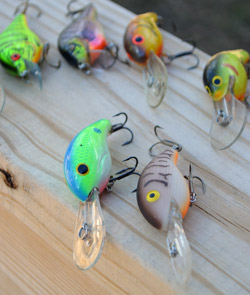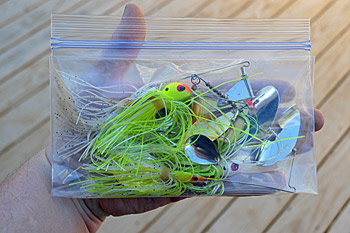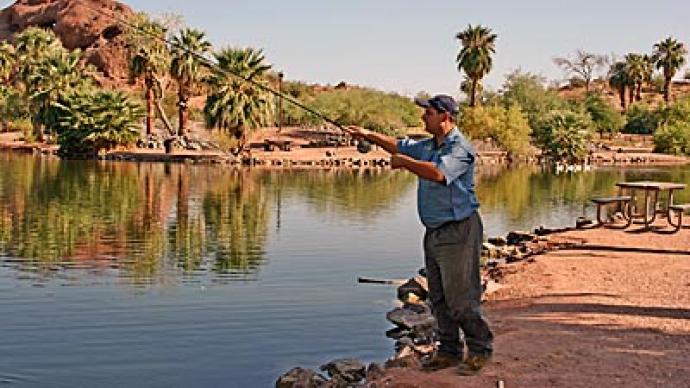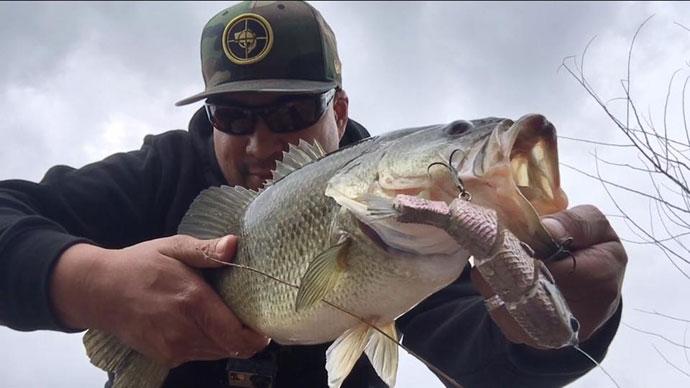
Bass anglers have one fear that outweighs all others: not having the particular lure — and rod and reel to present it — that bass want at any moment. So most own lures and rods and reels by the truckload. They hope that all the different sizes, colors, and actions will ensure they are prepared for any situation.
When fishing from a boat, there is plenty of room to stow all that gear. When you fill one compartment, you move to the next. Storage isn’t as convenient when you chase bass from the bank. You can bring only what you can carry.
You want to be able to move quickly and stealthy, presenting your lure at every opportunity, but you still need options. So each lure needs to serve several purposes or a range of conditions. The same goes for rods and reels. Here’s how to fill your tackle bag and select setups for fishing along the bank of streams, rivers, lakes, and reservoirs.
Hard baits

Every bass angler loves to fish topwater lures, so choose those first. Pack a minnow bait, such as an original Rapala, a walking bait like a Zara Spook, and a couple of loud topwaters. Start with a buzzbait and prop bait such as a Smithwick Devil’s Horse. The latter gives you the option of start-and-stop retrieves.
If bass won’t come up to eat your lure, you’ll need to go down after them. If you’re not concerned about it suspending, you can use your topwater minnow as a jerkbait. Carry shallow- and medium-diving crankbaits. You won’t be able to carry every shade and off-the-wall color, so stick with lures in natural colors and one in a bright color.
Spinnerbaits can cover a variety of depths. The same can be burned under the surface or slowly rolled through the depths. Bring one that’s ¼-ounce and one that’s ½-ounce. Using a combination of Colorado and willow leaf blades will ensure yours are attractive across the water-color spectrum.
Swim jigs cover different depths, too. Need to run it shallow? Start a fast retrieve as soon as it hits the water. Need to go a little deeper? Let it sink and turn your reel’s handle slowly. Pack a couple of ¼-ounce ones and a ½-ounce model. These jigs can double for pitching to targets and casting to deep water, so choose natural hues, such as green pumpkin, that imitate crawfish and bluegill.
Leave your deep-diving crankbaits at home. They reach maximum depth midway through a retrieve, and that’s when the water gets shallow when bank fishing. Instead, use a swimbait on a football head for deeper water. Swimbaits can double as trailers for swim jigs and be Texas rigged without weight for fan casting shallow-water cover.
Soft plastics
Like the famous potato chip commercial jingle, no bass angler can buy one bag of soft plastics. As soon as you pull one from a peg at the tackle shop, the thought — What if the bass like them? Will ten be enough? — it goes through your mind, and you grab a second bag. You can’t carry all of them while bank fishing, so the selection is critical here, too. The first to pack are stick worms such as Senkos.
Aggressive and inactive bass eat stick worms. They can be rigged Texas, Carolina, or wacky, with or without weight. That means you can fish in nearly every situation with them. Keep a few in the 4- and 5-inch sizes. They tend to quickly tear to the point that they are unusable, especially when rigged weedless. So pack more spares than you think you’ll need.
You’ll need jig trailers. Pick out some traditionally shaped ones, and use swimbaits when you need more action.
A bag of 4- and 6-inch finesse worms, such as Zoom’s Trick Worm, will cover this style of lure. Bring a selection of shakey heads and some worm hooks and bullet sinkers to Texas-rig them. The hooks and sinkers also can be used for swimbaits and the bag of creature baits, such as Reaction Innovation’s Sweet Beaver, that you’ll want to include. Again, stick to a dark color, such as black with red flake, and one that’s more translucent, such as watermelon or pumpkinseed.
Don’t forget soft-plastic toads, which can take the place of a buzzbait. Use a wide-gap hook equipped with a spring-shaped keeper. They don’t tear weedless rigged toads as fast as traditional hooks so that you can carry fewer baits. And bringing a bottle of superglue, which mends torn plastic, means you can carry fewer spare soft-plastic lures overall.
Bag them up

Now that you’ve selected your lures, you need to get them to the bank. If you’ve whittled them down to just a few based on the seasonal pattern, current condition, or specific water, you can use a small utility-style tackle box that might fit in a pocket. If you plan to pack a few more, you’ll need storage.
Tackle bags are the best option for bank anglers. They are easier than bulky traditional tackle boxes to carry. Nearly all accept utility boxes, so you can swap them out as conditions change. Bags have plenty of pockets to organize small items that don’t need boxes, such as tools and packages of hooks, weights, and soft plastics.
Bags you wear have one big benefit over the ones you carry: You don’t have to stop to put them down and then pick them up. That lets you keep moving and fishing. There are two styles, backpacks and sling packs. The first is self-explanatory, and they hold more tackle. Sling packs were designed for fly fishing but are big enough for a complete selection of conventional tackle. The strap goes across your body like a messenger bag. You release a stabilizing strap and swing the bag around the front when you need something. When you’re done, return it to your back and out of your way. The main strap has sleeves for frequently used tools such as clippers, scissors, or pliers.
Inside your bag, organize hard baits in utility boxes. Keep your soft plastics in resealable bags. They take up less room and fit in spots that boxes won’t. Use stack packs — round containers that screw together — to hold weights, hooks, jig heads, and other small components. They offer the protection of rigid boxes and take up less room.
Resealable freezer-style plastic bags are a great way to save space when storing spinnerbaits and buzzbaits. Lay them flat, one on top of another. Their single hooks don’t tangle like trebles, even when trailer hooks are installed. Remember to open the bags when you finish the day, so the lures will dry and not rust.
Rods and reels
Your bank fishing rods and reels need to be versatile, too. These combos each serve a different purpose but share characteristics.
Selecting length will depend on where you are fishing. If the bank is free of trees and vegetation, go with 7 feet or longer rods. They’ll give you extra casting distance. If you will be busting brush to the bank, pick a shorter rod, but try not to go less than 6 feet. While walking in, carry your rod with its tip pointing behind you. It’s easier than threading it through branches, and you are less likely to break it if you trip and fall. Load the reel with braid and use a monofilament or fluorocarbon leader. You won’t be able to unsnag your lure, so this combination will ensure you don’t lose yards of line because it will break at the leader. Plus, it takes less effort to cast farther.
If you plan to fish one technique, you already know which rod you’ll bring. But if you want to fish multiple lures, three setups — one spinning and two casting — will cover what you need.
A medium-action spinning rod that can handle baits to 3/8-ounce will cast any finesse lures you want to throw. It also can handle small crankbaits and topwaters. Its slower action flexes more, allowing even light lures to add load during a cast, which translates into flinging them farther.
The first casting rod should be medium action, handling up to ½- or 5/8-ounce lures. You’ll use this for spinnerbaits, topwaters, crankbaits, and swimbaits. Of the three rods, this is the workhorse. A 7-footer also will double as a pitching rod, especially for stick worms.
The last rod in your quiver will be a medium-heavy casting rod, which can handle baits up to ¾- or 1 ounce. You’ll use this one to flip heavy cover along the bank and launch jigs, worms, and cranks to deeper water. If the water or weather cancels out these techniques, this rod is the first to leave home.
BassResource may receive a portion of revenues if you make a purchase using a link above.




